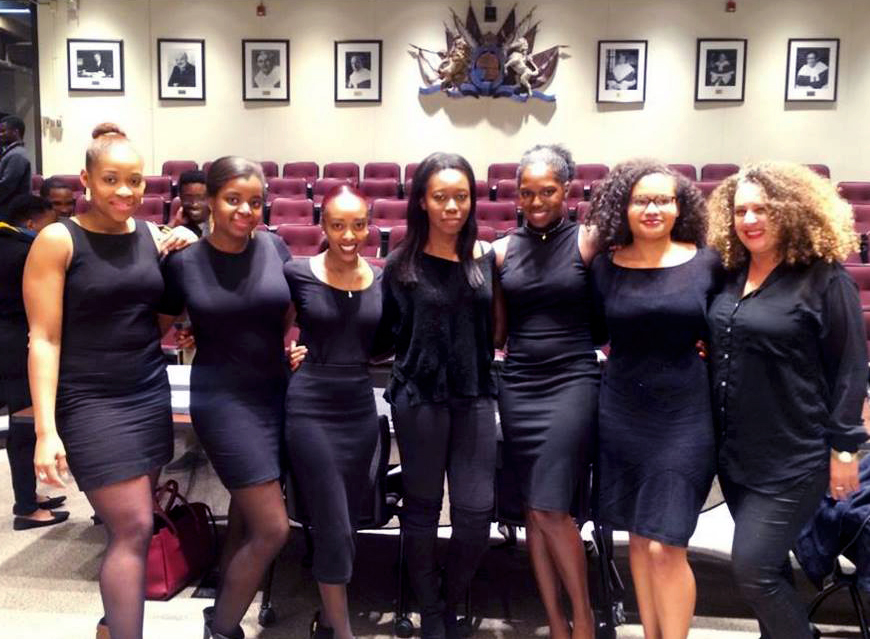On November 11, the Black Law Students’ Association of McGill (BLSAM) held a panel discussion titled “Black Women and the Law: Reclaiming Spaces and Changing the Narrative of Black Female Success.” The goal of the discussion was to shed light on the barriers that Black women face in the legal world.
The panelists included McGill law students Lillian Boctor, Samanthea Samuels, Stéphanie Déborah Jules, and Alyssa Clutterbock, and Université de Montréal law student Médigne Gourdet. The student panelists talked about their personal experiences and critical analyses regarding the intersection of Blackness and gender in the field of law.
Also present was Rachel Zellars, PhD candidate in the Department of Integrated Studies in Education, whose research focuses on critical race theory.
Representation versus reality
Samuels and Jules discussed the current media representation of Black women in the field of law, analysing three characters from popular TV shows: Kerry Washington as Olivia Pope in Scandal, Viola Davis as Annalise Keating in How to Get Away With Murder, and Gina Torres as Jessica Pearson in Suits.
“It’s important […] to use that media presence to actually talk about, ‘okay, this is TV. In reality, what’s happening?’”
Samuels and Jules acknowledged that such increased media presence of Black women in law is a positive change. Nevertheless, they said that the characters still enforce stereotypes, pointing to the hypersexualization of Olivia Pope and “angry Black woman” moments of Annalise Keating. While Samuels and Jules praised Jessica Pearson as a strong, self-determined individual they lamented the fact that she remains a supporting character in the show.
This discussion of Black female characters in TV served as a launching pad for the real focus of the evening: the reality of Black women in the field of law. According to Jules, “It’s important […] to use that media presence to actually talk about, ‘okay, this is TV. In reality, what’s happening?’”
“We’re not seeing those roles in real life,” Samuels said.
The panel presented statistics on the underrepresentation of Black people, and specifically Black women, in the legal world. For example, as of March 2013, only 286 of the 24,450 practicing lawyers and 72 of the 1,245 active law students in Quebec were Black.
“For a Black woman, law is far too often a barrier or a bludgeon, rather than any sort of bridge to justice.”
Clutterbuck approached this underrepresentation from a more personal angle, being one of two Black women in her class and the only Black woman in her law firm.
Gendered violence against Black women
Boctor addressed state violence against Black women. “For a Black woman, law is far too often a barrier or a bludgeon, rather than any sort of bridge to justice,” Boctor explained, focusing on a number of injustices faced by Black women, citing examples of sexual assault by police.
Zellars talked about how Black women are characterized in legal circumstances, where they are portrayed as “self-deprecating agents, things to be shamed, exposed, and ultimately disbelieved in their allegations of sexual violence.”
Blackness in law school and professional life
For Clutterbuck, the most difficult part about going through law school was attempting “to reconcile the fact that I have to write an exam […] using concepts that were once used to oppress my ancestors.”
Gourdet described an interview where she was rejected and was told that she did not look like “the image of our cabinet.” She also explained the difficulties that Black women face in having few role models in the legal profession, and in coming to terms with the fact that hard work alone is not enough to succeed.
“It’s really easy for the status quo to keep producing predictable results, which is that every year, the overwhelming majority of future lawyers are white, from upper middle-class backgrounds.”
The panelists emphasized the importance of unapologetically claiming space as Black women pursuing careers in law and moving forward.
“It’s really easy for the status quo to keep producing predictable results, which is that every year, the overwhelming majority of future lawyers are white, from upper middle-class backgrounds. […] In the spirit of wanting a bench across the country that is representative of the population, we need to continue to fight,” Clutterbuck said.
